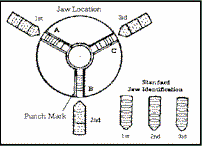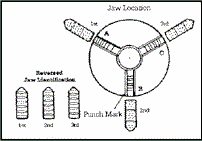SHERLINE 3-Jaw Self Centering Chucks
P/N 1040 3-Jaw Chuck, 3.125"
Diameter
CAUTION! DO NOT OVERTIGHTEN
CHUCK. Use only moderate pressure with the Tommy Bars supplied.
IMPORTANT! DO NOT TURN THE
LATHE SPINDLE ON UNLESS THE CHUCK IS TIGHTENED. Acceleration of the
spindle can cause the scroll to open the chuck jaws if they are not
tightened!
N0TE: To prevent permanent
damage to the chuck, finished, turned or drawn stock only should be held
with this chuck. For rough castings, etc., use the 4-jaw chuck.
Always wear your safety
glasses when operating metalworking equipment
|
Instructions for Use
Three-jaw chucks are designed so that
all three jaws move together and automatically center round or hexagonal
parts or stock to within a few thousandths of an inch. These chucks
provide the quickest and easiest way of holding work in the lathe.
The SHERLINE chuck is designed so that
it can be used to clamp externally on bar stock or internally on tube
stock. The P/N 1041 chuck is designed to grip from 3/32" (2mm) to
1-3/16" (30mm) diameter stock with the jaws in the normal position.
The P/N 1040 chuck handles stock up to 1-1/2" (38mm) in diameter. For
larger diameter work, the jaws must be reversed (See Figure 2). The
reversible jaws can grip to 2-1/4" (56.0 mm) for the P/N 1041 chuck
and up to 2.75" (70 mm) for the P/N 1040 chuck. The chucks have a
.687" (17mm) diameter through hole with a 3/4"-16 thread.
Due to the nature of the design of a
3-jaw chuck, it cannot be expected to run perfectly true. Even 3-jaw
chucks costing five times more than the one made for this lathe will have
a 0.002" to 0.003" runout. If perfect accuracy is desired in a
particular operation, the use of a 4-jaw chuck or a collet is recommended.
Both are available for your SHERLINE Lathe.
|
|

FIGURE 1—Three-Jaw
Chuck, standard jaw locations
|

FIGURE
2—Reversing the Chuck Jaws
|
| NOTE: Always
start with position "A". To reverse the chuck jaws, rotate the
knurled scroll until the jaws can be removed. They can be easily
identified by the location of the teeth to the end of the jaw (See Figures
1 and 2). To maintain chuck accuracy, the 2nd jaw must always be inserted
in the same slot even when the jaws are reversed. This slot is identified
by a punch mark next to the slot. Always insert the jaws in the order and
location shown on the drawings. Turn the scroll counter-clockwise when
viewed from the face of the chuck until the outside start of the scroll
thread is just ready to pass the slot for the 1st jaw. Slide the 1st jaw
as far as possible into the slot. Turn the scroll until the 1st jaw is
engaged.
Due to the close tolerances between
the slot and jaw, the most difficult part of replacing the jaws is
engaging the scroll thread and 1st jaw tooth without binding. Therefore,
never use force when replacing the jaws, and if binding occurs, back up
the scroll slightly and wiggle the jaw until it is free to move in the
slot. Advance the scroll and repeat for the 2nd and 3rd jaws. The scroll
thread must engage the first tooth in the 1st, 2nd and 3rd jaws in order. |



 Click
for details
Click
for details